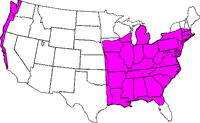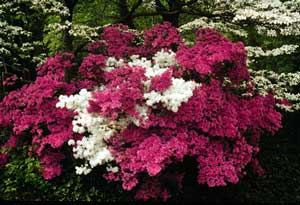 |
Azaleas (Rhododendron sp.), members of the rhododendron family of shrubs, are extremely popular for home landscapes because of their elegant spring masses of colorful funnel-shaped flowers. Among the most valued are those azaleas from Asia and the hybrids that have been bred from them. Their evergreen foliage also offers winter interest in residential yards. Although all azaleas are difficult to grow where soil is clayey, soil pH is alkaline or where summers are very hot, they are reliable, carefree shrubs when their environmental requirements are met.
 |
| Area Where Azalea Is Native |
Most evergreen azalea varieties have southern backgrounds and are coldhardy only as far north as Kentucky and Virginia and along the Atlantic coast to Southern New England (zone 6). While there are exceptions, most can not withstand winter temperatures lower than -10°F.
Size: Evergreen azaleas tend to be compact and bushy. They grow from 4 to 6 feet or more, depending on the variety. Individual plants are often as wide as they are tall.
Foliage: Evergreen azaleas offer fall and winter interest as well as spring beauty. Their leaves are usually about 1 inch long, elliptic to lance-shaped and bristly to the touch. Medium to dark green in the summer, they turn bronze or reddish brown in the fall and through the winter.
 |
Flowers: Azalea flowers are funnel-shaped with flaring petals. Some varieties boast semi-double and double blossoms, and are almost unrivaled for their spectacular spring show. Flowers 1 to 3 inches in diameter range in color from white through pink, red or lavender, and even shades of yellow, salmon, apricot or orange. They are often carried in loose clusters along the stems, literally covering the shrubs in a gorgeous display.
Basic Requirements - Zones 5 - 8, part shade, and acidic well drain soil.

